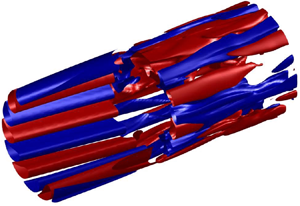Published online by Cambridge University Press: 12 August 2020

Direct numerical simulations, performed with a high-order spectral-element method, are used to study coherent structures in turbulent pipe flow at friction Reynolds numbers  $Re_{\tau } = 180$ and
$Re_{\tau } = 180$ and  $550$. The database was analysed using spectral proper orthogonal decomposition (SPOD) to identify energetically dominant coherent structures, most of which turn out to be streaks and quasi-streamwise vortices. To understand how such structures can be modelled, the linear flow responses to harmonic forcing were computed using the singular value decomposition of the resolvent operator, using the mean field as a base flow. The SPOD and resolvent analysis were calculated for several combinations of frequencies and wavenumbers, allowing the mapping out of similarities between SPOD modes and optimal responses for a wide range of relevant scales in turbulent pipe flows. In order to explore physical reasons behind the agreement between both methods, an indicator of lift-up mechanism in the resolvent analysis was introduced, activated when optimal forcing is dominated by the wall-normal and azimuthal components, and associated response corresponds to streaks of streamwise velocity. Good agreement between leading SPOD and resolvent modes is observed in a large region of parameter space. In this region, a significant gain separation is found in resolvent analysis, which may be attributed to the strong amplification associated with the lift-up mechanism, here understood as nonlinear forcing terms leading to the appearance of streamwise vortices, which in turn form high-amplitude streaks. For both Reynolds numbers, the observed concordances were generally for structures with large energy in the buffer layer. The results highlight resolvent analysis as a pertinent reduced-order model for coherent structures in wall-bounded turbulence, particularly for streamwise elongated structures corresponding to near-wall streamwise vortices and streaks.
$550$. The database was analysed using spectral proper orthogonal decomposition (SPOD) to identify energetically dominant coherent structures, most of which turn out to be streaks and quasi-streamwise vortices. To understand how such structures can be modelled, the linear flow responses to harmonic forcing were computed using the singular value decomposition of the resolvent operator, using the mean field as a base flow. The SPOD and resolvent analysis were calculated for several combinations of frequencies and wavenumbers, allowing the mapping out of similarities between SPOD modes and optimal responses for a wide range of relevant scales in turbulent pipe flows. In order to explore physical reasons behind the agreement between both methods, an indicator of lift-up mechanism in the resolvent analysis was introduced, activated when optimal forcing is dominated by the wall-normal and azimuthal components, and associated response corresponds to streaks of streamwise velocity. Good agreement between leading SPOD and resolvent modes is observed in a large region of parameter space. In this region, a significant gain separation is found in resolvent analysis, which may be attributed to the strong amplification associated with the lift-up mechanism, here understood as nonlinear forcing terms leading to the appearance of streamwise vortices, which in turn form high-amplitude streaks. For both Reynolds numbers, the observed concordances were generally for structures with large energy in the buffer layer. The results highlight resolvent analysis as a pertinent reduced-order model for coherent structures in wall-bounded turbulence, particularly for streamwise elongated structures corresponding to near-wall streamwise vortices and streaks.